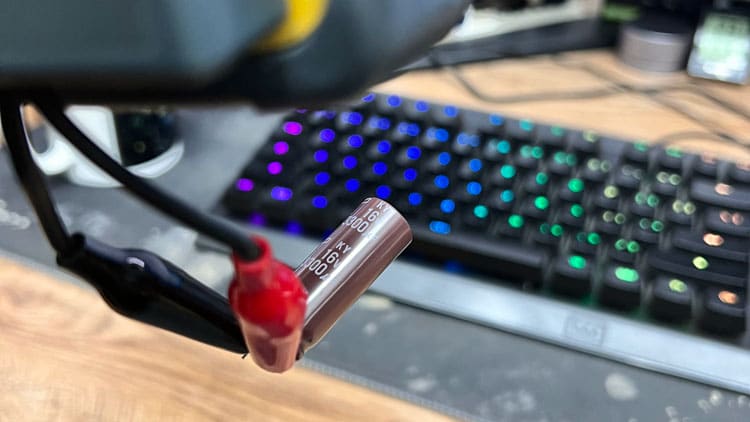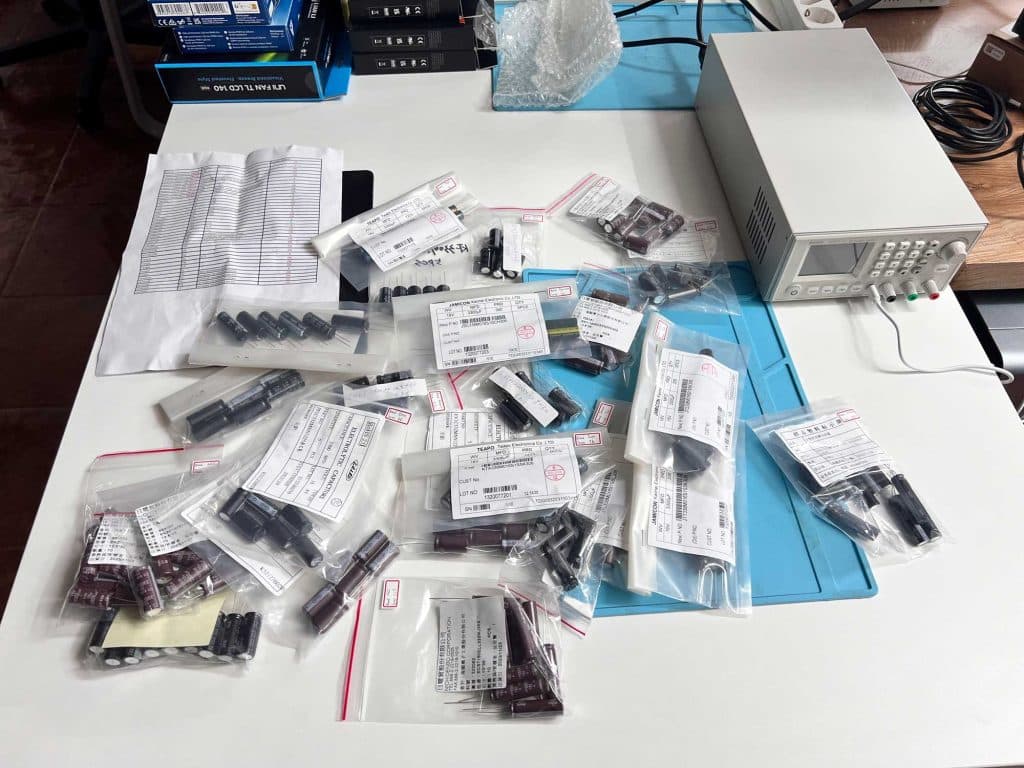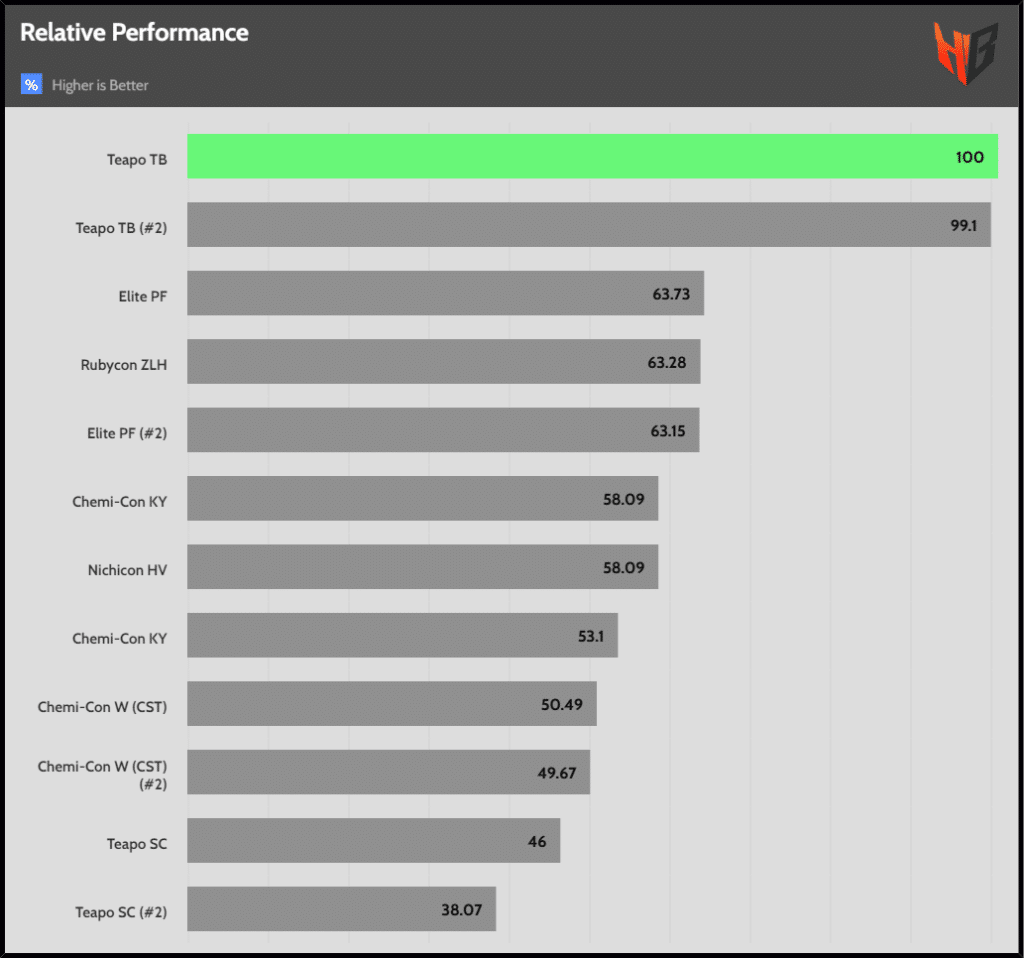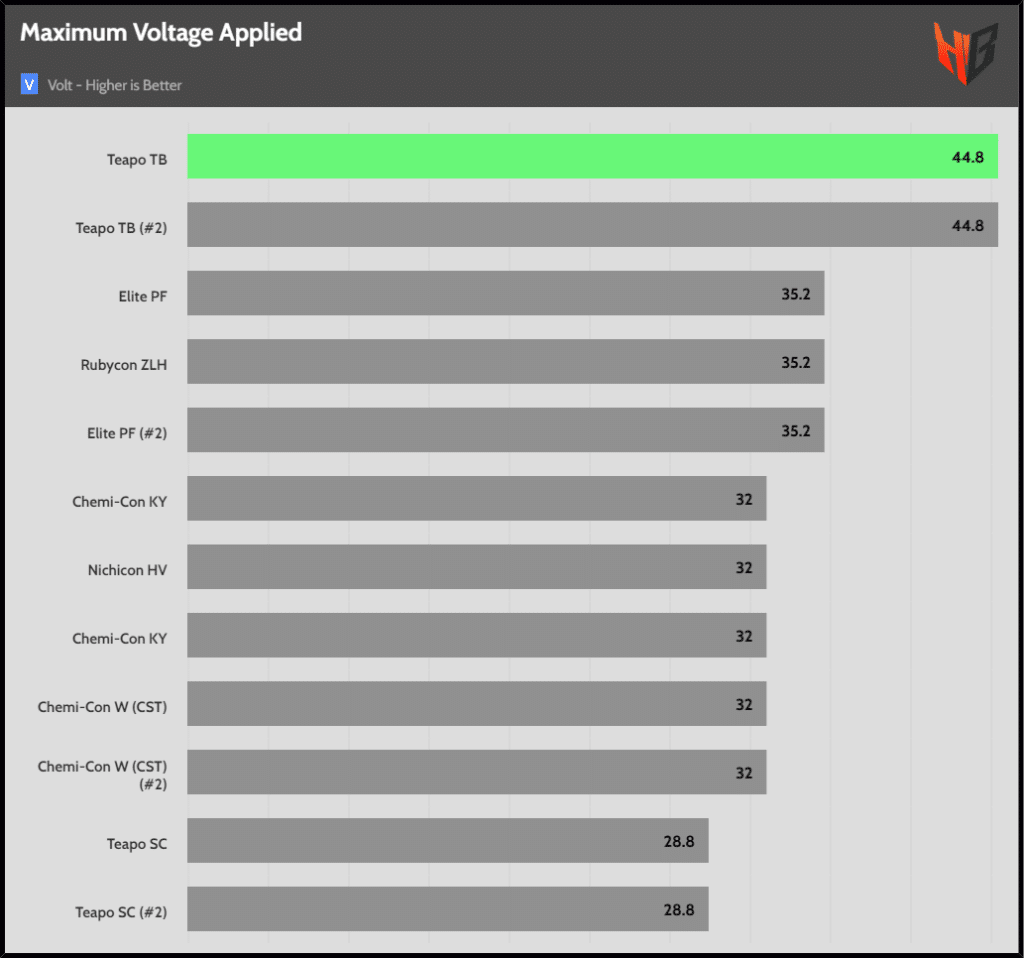This is a database with the best electrolytic capacitors based on actual testing that we conduct in our lab! Not rumors, not speculation, but pure data results to find the best electrolytic capacitors!
You will find all the related theory behind the testing procedure I use and the complete methodology in the article below:
Many thanks for sending me all the capacitors in the photo above for testing. I hope more brands will help me in this new endeavor.
Capacitor Performance Database
| Brand | Series | Voltage Rating (V) | Claimed Capacity (uF) | Measured Capacity (uF @ 120 Hz) |
Max Applied Voltage Level (V) | Time (Sec) | Performance (%)* | Date |
|---|---|---|---|---|---|---|---|---|
| Teapo | TB | 16 | 3300 | 3090 | 44.8 | 2448 | 100 | 5 April 2024 |
| Teapo | TB | 16 | 3300 | 3080 | 44.8 | 2426 | 99.1 | 5 April 2024 |
| Elite | PF | 16 | 3300 | 3090 | 35.2 | 1560 | 63.73 | 15 Feb. 2024 |
| Rubycon | ZLH | 16 | 3300 | 3170 | 35.2 | 1549 | 63.28 | 6 April 2024 |
| Elite | PF | 16 | 3300 | 3080 | 35.2 | 1546 | 63.15 | 5 April 2024 |
| Chemi-Con | KY | 16 | 3300 | 3190 | 32 | 1422 | 58.09 | 15 Feb. 2024 |
| Nichicon | HV | 16 | 3300 | 3100 | 32 | 1422 | 58.09 | 5 April 2024 |
| Chemi-Con | KY | 16 | 3300 | 3200 | 32 | 1300 | 53.10 | 13 Feb. 2024 |
| Chemi-Con | W (CST) | 16 | 3300 | 2790 | 32 | 1236 | 50.49 | 31 March 2023 |
| Chemi-Con | W (CST) | 16 | 3300 | 2780 | 32 | 1216 | 49.67 | 9 Nov. 2023 |
| Teapo | SC | 16 | 3300 | 3120 | 28.8 | 1126 | 46 | 13 Feb. 2024 |
| Teapo | SC | 16 | 3300 | 3100 | 28.8 | 932 | 38.07 | 9 Nov. 2023 |
*The best cap is used as a reference: 100% performance rating
The Teapo TB series belonged to Jamicon, but since Teapo acquired this brand, it was included in its portfolio. The performance of the TB caps is outstanding, putting to shame high-end caps by respected manufacturers like Chemi-Con, Rubycon, and Nichicon! This was a totally unexpected result! At some point, I wondered whether the cap was getting any voltage because it exceeded 40V without sweating. The second surprise in the table above is the performance that the Elite PF caps registered, taking the lead from capacitors like the Chemi-Con KY and W and the Nichicon HV while matching the performance of the Rubycon ZLH.
Performance Charts
Electrolytic caps are the essential ingredient for a good PSU. To check the PSU offerings, read my Best ATX v3.x PSUs article before investing in a new power supply. You help me a lot by using my affiliate links, which don’t increase the product’s price. I get a commission from Amazon every time you do it, which can make a difference for me, especially now that I am on my own, working exclusively for my media and not for someone else.








Hello Aris, would you say your capacitor manufacterer tier list at tom’sHARDWARE is still relevant for today or is it currently innacurate, after all, it is 10 years old.
Basically right now I’m wondering if CapXon elotrolytic capacitors are still considered to be Third Tier.
I would suggest look at the Cybenetics capacitor performance database, which use real data.
Thanks for the reply!! Will do.
I would like to know the evaluation of the legendary CHENGX….
Hello
I have frequent blackouts in my area and i’m afraid this might cause damage to my PC parts. I have heard people say that consumer grade UPS’ do more harm than good so its better to just stick with a good PSU. Is that true, and what are the factors (like transient response , hold up time etc) of a PSU to consider that will help with frequent black outs.
Thanks
This is not accurate. I use many consumer-grade PSUs and save the day when something goes wrong. Hold-up time is of the essence, as the capacity of the UPS, and the switch-over time to the battery.
…and there are some consumer grade line-interactive UPS (around €100 mark … depending on the required wattage or hold-up time) with switch-over time around or below 4 ms.
Though, a good noise profile or abundant protection features can move the price further north of €100 mark…
Make sure that the UPS you get outputs a true sine wave (typically sold as PFC) rather than a stepped sine wave (often sold as AVR.) Modern power supplies with APFC will not play well with stepped sine waves, or if your power supply does not have APFC, you should probably change that.
This is incorrect information. AVR has nothing to do with the sine-wave. AVR stands for “Automatic Voltage Regulation”. It’s what makes the difference between a standby and line interactive UPS. A line interactive UPS has an AVR that boosts and bucks the voltage as there are drops and rises in the mains voltage.
And APFC hasn’t cared about pure-sine vs. step-sine for over a decade. The PWM controllers used in 99% of the PSUs made in the last 10+ years (maybe even 15 years) have been able to handle stepped sine-wave without any issues.